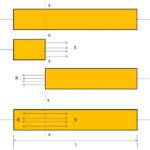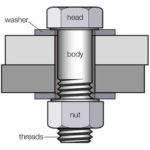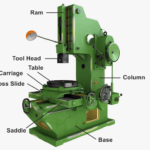In this article, we will learn about the various mechanical properties of materials. Knowing about them is very important to identify any material. It is the mechanical properties which provide the correct information about where the materials can be used. They are the measure of strength and how long the material can exist in its service. They play a key role in the design of tools, machines and structures.

14-Mechanical Properties of Materials
The important mechanical properties of materials are
1. Strength:
When an external load is applied on a material, then the capacity of the material to withstand that load without destruction is called the strength of a material.
- The stronger the material the greater the load it can handle. Therefore it determines the ability of a material to withstand stress without failure.
- The strength of materials varies according to the types of load.
- The maximum stress that a material can withstand before destruction is called the ultimate strength.
- The tenacity of a material is the value of its ultimate strength in tension.
2. Elasticity:
The ability of a material to return to its original position after deformation when the external load acting on it is removed is called elasticity.
- Elasticity is the tensile property of the material.
3. Stiffness:
The resistance of a material to elastic deformation or deflection is called stiffness or rigidity.
- A material that suffers less deformation under the action of load possesses a high degree of stiffness or rigidity.
- For example a steel and aluminium beam is suspended. Both are enough strong to carry the required load but there is a greater deflection in the aluminium beam. This indicates that the steel beam has a greater stiffness than the aluminium beam.
- If the material is following Hooke’s law, in that case the stiffness of material is measured by young’s modulus E. The higher the value of the young’s modulus the more will be the stiffness.
- In tensile and compressive stress, it is called as modulus of stiffness or modulus of elasticity; In shear, modulus of rigidity; in volumetric distortion, the bulk modulus.
4. Flexibility:
It is defined as the ability of the material to bend easily. This mechanical properties of materials allow it to form in any shape.
Also Read:
- What is Slotter Machine?
- What is Rockwell Hardness Test?
- What is Lathe Machine? Main parts, Operations and Working
5. Plasticity:
Plasticity is defined as the ability of a material to undergo some degree of permanent deformation without rupture or failure.
- The plastic deformation appears when the material is stressed beyond the elastic range.
- Plasticity is important in shaping, forming, extruding and many other hot or cold working process.
- Generally plasticity increases with the increase in temperature.
6. Ductility:
It is the property of a material by which it can be drawn into thin wires. The materials that possess this property are used in wire industries for manufacturing of wires. For example: gold, copper, iron,
mild steel etc.
7. Malleability:
Malleability is the ability of a material to be hammered into thin sheets. Aluminium, copper, silver, tin, steel etc are malleable metals.
8. Toughness:
Toughness is defined as the ability of a material to withstand both the plastic and elastic deformation. In other word, it is the measure of the amount of energy a material can absorb before actual fracture or
failure takes place.
- The materials that possess this property are used in the manufacturing of structural and machine parts which have to withstand shock and vibration.
9. Resilience:
It is the capacity or ability of a material to absorb energy elastically. And on the removal of the load this absorbed energy is given off same as spring does.
- The maximum energy that can be stored in a body upto elastic limit is called the proof resilience. And the proof resilience per unit volume is called a modulus of resilience.
- The materials having this property are used to manufacture springs. This property gives capacity to a material to bear shocks and vibration.
10. Hardness:
The ability of a material by which it is able to resist scratching, cutting, abrasion, indentation or penetration. It is closely related to strength.
Also Read:
11. Brittleness:
It is defined as the property of breaking of materials without much permanent distortion.
- There are so many materials which break without showing much permanent distortion. Such materials are said to be brittle such as glass and cast iron.
- Brittleness is the opposite of ductility.
12. Machinability:
It is the ability of the material to be cut easily by a sharp tool.
- The machinability of a metal is indicated by percentages which is called machinability index. All machinable metals are compared to a basic standard. The standard metal used for the 100 percent machinability is free cutting steel.
- The machinability index of carbon steels generally ranged from 40 to 60 per cent and that of cast iron from 50 to 80 percent. The metals with higher range of machinability index can be machined or cut easily.
13. Creep:
The creep is defined as the slow and progressive deformation of a material with the passage of time when it is subjected to constant stress. Viscous flow is the simplest type of creep deformation.
- In other words, it is also defined as the time-dependent strain occurring under stress.
- The creep deformation occurs in a material which is exposed for a long time to high level of stresses that are below yield strength.
- There are three stages of creep.
- In the first stage the material elongates rapidly but at a decreasing rate.
- In the second stage, the rate of elongation is constant.
- In the third stage, the rate of elongation increases rapidly until the material fails.
14. Fatigue:
The phenomenon of weakening of material, when it is subjected to repeated or fluctuating stress, is called fatigue.
- When a material is subjected to cyclic or fluctuating loading, there appear a minute cracks and these cracks grow with time and finally, the materials get fractured.
Mechanical Properties of Materials in Tabular Form
| S.no | Mechanical Property | Definition of the Mechanical Property |
| 1. | Strength | The capacity of a material to withstand load without destruction. |
| 2. | Elasticity | The ability of the material to return to its original condition after deformation on the removal of external load. |
| 3. | Stiffness | Resistance to elastic deformation or deflection |
| 4. | Flexibility | The ability of the material to be bend. |
| 5. | Plasticity | The ability of a material to undergo some degree of permanent deformation without rupture or failure. |
| 6. | Ductility | The ability of the material to be drawn into thin wires. |
| 7. | Malleability | The ability of the material to be hammered into thin sheets. |
| 8. | Toughness | The ability of a material to withstand both the elastic and plastic deformation. |
| 9. | Resilience | The capacity or ability of a material to absorb energy elastically. |
| 10. | Hardness | The ability of a material to resist scratching, cutting, abrasion, indentation or penetration. |
| 11. | Brittleness | The property of breaking of materials without much permanent distortion. |
| 12. | Machinability | It is the ability of the material to be cut easily |
| 13. | Creep | The slow and progressive deformation of a material with the passage of time when it is subjected to constant stress. |
| 14. | Fatigue | The phenomena of weakening of material when it is subjected to repeated or fluctuating stress. |
This is all about the mechanical properties of materials. If you find this piece of information useful then don’t forget to like and share it.








